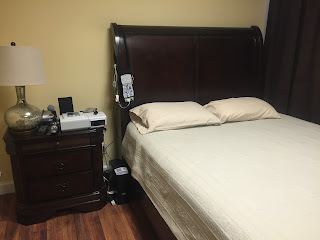You arrive a little early because you're excited to do this thing, and you know it's OK because you're the first (8:00) appointment. Glenn, the same technologist you had last time, lets you in, and you declare, "I'm back!" He gives you some paperwork and escorts you to your room.
Since you live so close to the sleep center (you could walk there if you wanted), you've shown up all ready for bed - teeth brushed, medication taken, jammies on - so you don't need to change or anything.
Glenn wheels in a cart with a million drawers similar to the ones you often see in salons, pulls the rolling chair into the middle of the room and has you sit down. First, he tries a CPAP mask on you for size (after determining that you need a full-face mask because you breathe through your mouth in your sleep). It's not quite right, so he gets a smaller size. For the better part of 45 minutes, you chat with Glenn while he attaches various sensors and electrodes to you - not just on your scalp, but also on your face, torso, and shins.
The last two steps are attaching the pulse/ox monitor to one index finger and putting on the CPAP mask, and you're all ready for bed. Glenn says good night, turns out the light, closes the door, and goes to set up the patient with the 9:00 appointment. You wonder if the machine is really as silent as it seems or if your lousy hearing is just making it seem that way, then set about going to sleep.
When the study begins, the CPAP machine is on a low setting, but as you sleep, Glenn remotely turns up the setting gradually, trying to find the sweet spot where you have 0 "incidents" per hour instead of the 25 per hour you average without the mask. (This is only considered "moderate" sleep apnea, by the way. A patient last night had "severe" sleep apnea - 200 incidents per hour. That patient got frustrated at 1a.m. and gave up on the study. You, however, are determined that this will work for you.)
Glenn comes in once during the night (he uses a small flashlight instead of turning on the overhead light) to tell you not to smoosh the pulse/ox sensor or it doesn't work, and it looks like you've died, so you move your arm.
Later, how much later, you have no idea, you wake up and realize that something feels funny; air is blowing on your face. Somehow, the mask has come loose, and the seal has broken. Sleepy as you are, you try to fix it yourself, even though your dexterity is reduced due to the pulse/ox monitor on your dominant hand. After several tries, you realize you can't do it. "Hey, Glenn," you say with the mask over your face. "Oh, you can't hear that," you mutter, but the door opens, and in pops Glenn with his little flashlight. You explain the problem, and he tightens it up. Glenn tells you it will be easy to do it yourself at home because you won't have all the extra stuff attached to you. All better! It takes a bit, but you are able to go back to sleep.
The next thing you know, it's 5:30 a.m., Glenn has turned on the light, and he's removing all your sensors and electrodes while you lie there, waking up. After a little morning paperwork, you put your sweatshirt, hat, glasses, and shoes on, get in your car, and you're home by 6:00.
Now, you wait for your follow-up appointment with the M.D., where you will get the "prescription" for your coveted CPAP machine.
P.S. When you do the initial diagnostic sleep study without the CPAP, you look like this:






No comments:
Post a Comment